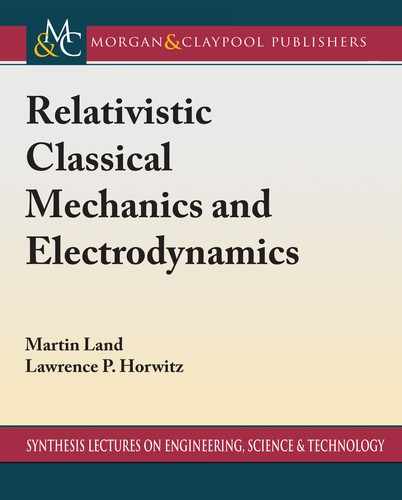
3.5. THE 5D WAVE EQUATION AND ITS GREEN’S FUNCTIONS 33
with a time-dependence characteristic of an Ornstein–Uhlenbeck process with correlation
length . is correlation suggests that the current ensemble may be seen as the set of instan-
taneous currents induced by an event undergoing a Brownian motion that produces random
displacement in under viscous drag along the worldline.
3.5 THE 5D WAVE EQUATION AND ITS GREEN’S
FUNCTIONS
Using (3.5) to expand (3.17) leads to the wave equation
@
ˇ
f
˛ˇ
D @
ˇ
@
˛
a
ˇ
@
ˇ
a
˛
D @
ˇ
@
ˇ
a
˛
D
@
@
C
55
c
2
5
@
2
a
˛
D
e
c
j
˛
'
; (3.22)
where we work in the 5D Lorenz gauge @
ˇ
a
ˇ
D 0. As discussed above, this form partially pre-
serves 5D symmetries broken by the O(3,1) symmetry of the event dynamics. A Green’s function
solution to
@
@
C
55
c
2
5
@
2
G.x; / D ı
4
.
x
/
ı
.
/
can be used to obtain potentials in the form
a
˛
.
x;
/
D
e
c
Z
d
4
x
0
d
0
G
x x
0
;
0
j
˛
'
x
0
;
0
: (3.23)
e Green’s function can be expressed as the Fourier transform
G.x; / D
1
.2/
5
Z
C
d
5
k
e
ik
˛
x
˛
k
˛
k
˛
D
1
.2/
5
Z
C
d
4
k d e
i.kxCc
5
55
/
1
k
2
C
55
2
over an appropriate contour C . To break the 5D symmetry present in the wave equation, we
leave the integration for last, writing
G.x; / D
1
2
Z
d e
ic
5
55
x;
55
2
;
where .x; m
2
/ is Schwinger’s principal part Green’s function [9] associated with the Klein–
Gordon equation for a particle of mass m. Carefully repeating the steps of Schwinger’s deriva-
tion, while allowing
55
to be positive or negative, we are led to
G.x; / D
1
.
2
/
2
Z
d e
ic
5
55
ı
x
2
C
55
x
2
@
@x
2
J
0
ˇ
ˇ
x
2
ˇ
ˇ
1=2
:
Now performing the integration, the pre-Maxwell Green’s function becomes
G.x; / D
1
2
ı.x
2
/ı. /
c
5
2
2
@
@x
2
.
55
g
˛ˇ
x
˛
x
ˇ
/
1
q
55
g
˛ˇ
x
˛
x
ˇ
(3.24)
..................Content has been hidden....................
You can't read the all page of ebook, please click here login for view all page.
